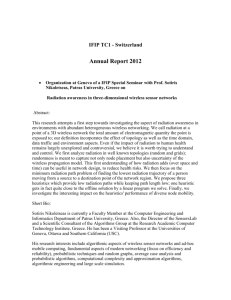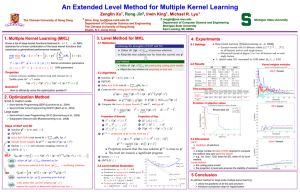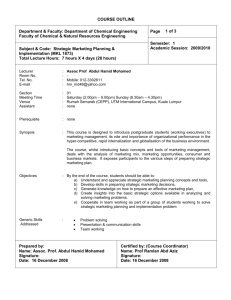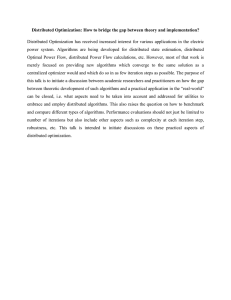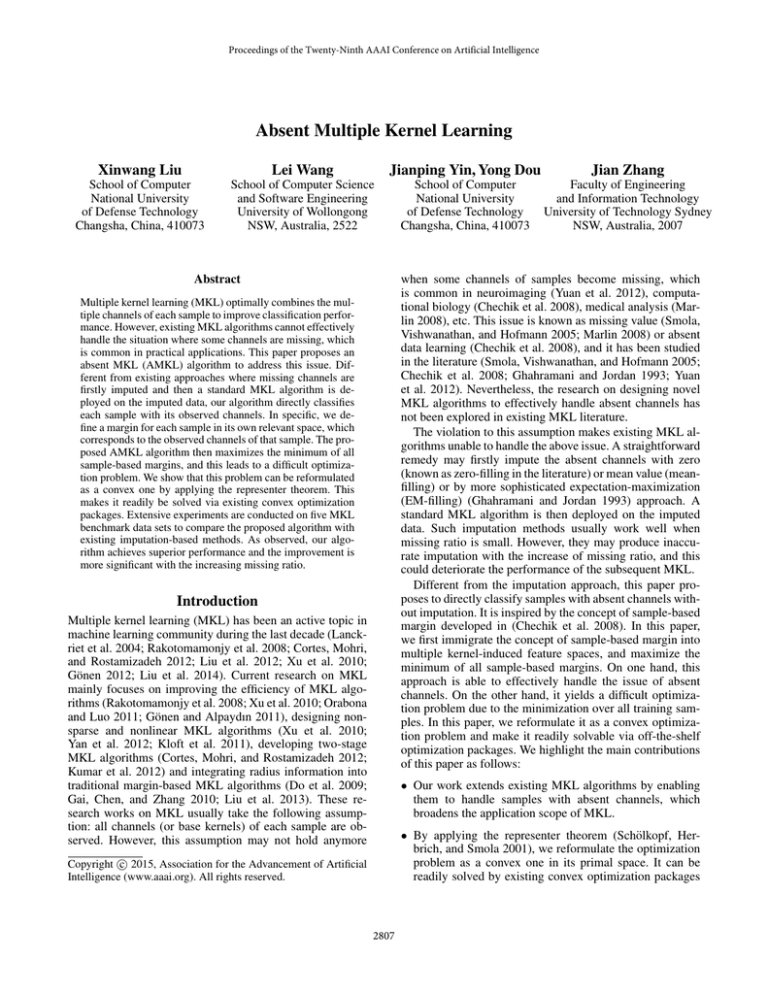
Proceedings of the Twenty-Ninth AAAI Conference on Artificial Intelligence
Absent Multiple Kernel Learning
Xinwang Liu
Lei Wang
Jianping Yin, Yong Dou
Jian Zhang
School of Computer
National University
of Defense Technology
Changsha, China, 410073
School of Computer Science
and Software Engineering
University of Wollongong
NSW, Australia, 2522
School of Computer
National University
of Defense Technology
Changsha, China, 410073
Faculty of Engineering
and Information Technology
University of Technology Sydney
NSW, Australia, 2007
Abstract
when some channels of samples become missing, which
is common in neuroimaging (Yuan et al. 2012), computational biology (Chechik et al. 2008), medical analysis (Marlin 2008), etc. This issue is known as missing value (Smola,
Vishwanathan, and Hofmann 2005; Marlin 2008) or absent
data learning (Chechik et al. 2008), and it has been studied
in the literature (Smola, Vishwanathan, and Hofmann 2005;
Chechik et al. 2008; Ghahramani and Jordan 1993; Yuan
et al. 2012). Nevertheless, the research on designing novel
MKL algorithms to effectively handle absent channels has
not been explored in existing MKL literature.
The violation to this assumption makes existing MKL algorithms unable to handle the above issue. A straightforward
remedy may firstly impute the absent channels with zero
(known as zero-filling in the literature) or mean value (meanfilling) or by more sophisticated expectation-maximization
(EM-filling) (Ghahramani and Jordan 1993) approach. A
standard MKL algorithm is then deployed on the imputed
data. Such imputation methods usually work well when
missing ratio is small. However, they may produce inaccurate imputation with the increase of missing ratio, and this
could deteriorate the performance of the subsequent MKL.
Different from the imputation approach, this paper proposes to directly classify samples with absent channels without imputation. It is inspired by the concept of sample-based
margin developed in (Chechik et al. 2008). In this paper,
we first immigrate the concept of sample-based margin into
multiple kernel-induced feature spaces, and maximize the
minimum of all sample-based margins. On one hand, this
approach is able to effectively handle the issue of absent
channels. On the other hand, it yields a difficult optimization problem due to the minimization over all training samples. In this paper, we reformulate it as a convex optimization problem and make it readily solvable via off-the-shelf
optimization packages. We highlight the main contributions
of this paper as follows:
Multiple kernel learning (MKL) optimally combines the multiple channels of each sample to improve classification performance. However, existing MKL algorithms cannot effectively
handle the situation where some channels are missing, which
is common in practical applications. This paper proposes an
absent MKL (AMKL) algorithm to address this issue. Different from existing approaches where missing channels are
firstly imputed and then a standard MKL algorithm is deployed on the imputed data, our algorithm directly classifies
each sample with its observed channels. In specific, we define a margin for each sample in its own relevant space, which
corresponds to the observed channels of that sample. The proposed AMKL algorithm then maximizes the minimum of all
sample-based margins, and this leads to a difficult optimization problem. We show that this problem can be reformulated
as a convex one by applying the representer theorem. This
makes it readily be solved via existing convex optimization
packages. Extensive experiments are conducted on five MKL
benchmark data sets to compare the proposed algorithm with
existing imputation-based methods. As observed, our algorithm achieves superior performance and the improvement is
more significant with the increasing missing ratio.
Introduction
Multiple kernel learning (MKL) has been an active topic in
machine learning community during the last decade (Lanckriet et al. 2004; Rakotomamonjy et al. 2008; Cortes, Mohri,
and Rostamizadeh 2012; Liu et al. 2012; Xu et al. 2010;
Gönen 2012; Liu et al. 2014). Current research on MKL
mainly focuses on improving the efficiency of MKL algorithms (Rakotomamonjy et al. 2008; Xu et al. 2010; Orabona
and Luo 2011; Gönen and Alpaydın 2011), designing nonsparse and nonlinear MKL algorithms (Xu et al. 2010;
Yan et al. 2012; Kloft et al. 2011), developing two-stage
MKL algorithms (Cortes, Mohri, and Rostamizadeh 2012;
Kumar et al. 2012) and integrating radius information into
traditional margin-based MKL algorithms (Do et al. 2009;
Gai, Chen, and Zhang 2010; Liu et al. 2013). These research works on MKL usually take the following assumption: all channels (or base kernels) of each sample are observed. However, this assumption may not hold anymore
• Our work extends existing MKL algorithms by enabling
them to handle samples with absent channels, which
broadens the application scope of MKL.
• By applying the representer theorem (Schölkopf, Herbrich, and Smola 2001), we reformulate the optimization
problem as a convex one in its primal space. It can be
readily solved by existing convex optimization packages
c 2015, Association for the Advancement of Artificial
Copyright Intelligence (www.aaai.org). All rights reserved.
2807
such as CVX (CVX Research 2012).
one in traditional SVMs. In (Chechik et al. 2008), a twostep iterative optimization procedure is proposed to solve the
problem. However, the optimization in (Chechik et al. 2008)
is non-convex and the global optimum is not guaranteed to
be obtained.
• We conduct comprehensive experiments to compare the
proposed algorithm with existing imputation-based methods on multiple MKL benchmark data sets. The results
verify the superiority of the proposed algorithm, especially in the presence of intensive absence of channels.
Multiple Kernel Learning
We end up this section by discussing the differences between our work and the work in (Chechik et al. 2008)
which inspires us. Both papers classify samples with missing observations by maximizing the sample-based margin.
However, they have the following important differences: (1)
Our algorithms directly work on kernel matrices and handle the case where some entries of kernel matrices are missing. However, the algorithm in (Chechik et al. 2008) only
considers the absence of input features; (2) Different from
developing a two-step iterative algorithm to solve the resulting optimization problem as in (Chechik et al. 2008),
we design a novel algorithm that directly solves the problem in the primal space by employing the representer theorem (Schölkopf, Herbrich, and Smola 2001). More importantly, the latter consistently achieves significant improvements over the former, as validated by our experimental results; and (3) In addition, our work assumes that some channels1 of samples are missing, while the work in (Chechik et
al. 2008) studies the problem that some individual features
of samples are missing. Form this perspective, the work in
(Chechik et al. 2008) can be treated as a special case when
a linear kernel is applied to all channels and each single feature is viewed as a channel.
MKL provides an elegant framework which not only learns
a data-dependent optimal kernel for a specific application
but also integrates multiple heterogeneous channels (Rakotomamonjy et al. 2008; Xu et al. 2010; Cortes, Mohri, and
Rostamizadeh 2010). In MKL, each sample can be treated as
a concatenation of multiple base kernel mappings. Specifically, each sample in MKL takes the form of
>
>
>
φ(·) = [φ>
1 (·), φ2 (·), · · · , φm (·)] ,
where {φp (·)}m
p=1 are the feature mappings corresponding
to m pre-defined base kernels {κp (·, ·)}m
p=1 , respectively.
Based on this definition, the seminal work in MKL (Lanckriet et al. 2004) proposes to optimize the problem in Eq. (2),
n
2
X
1 Xm
ξi ,
kω p kHp + C
p=1
ω,b,ξ 2
i=1
Xm
s.t. yi
ω>
p φp (xi ) + b ≥ 1 − ξi , ξi ≥ 0, ∀i,
min
(2)
p=1
where ω p is the normal vector corresponding to the p-th
base kernel, b is the bias, ξ consists of the slack variables
and Hp is a Hilbert space corresponding to base kernel κp .
Note that the MKL formulation in Eq. (2) can be equivalently rewritten as those in (Rakotomamonjy et al. 2008;
Xu et al. 2010) according to (Xu et al. 2010).
As can be seen in Eq. (1), each sample in current MKL is
>
>
>
assumed to be φ(xi ) = [φ>
1 (xi ), φ2 (xi ), · · · , φm (xi )] . A
question naturally raised is that how to perform MKL when
some channels, i.e., part of {φp (xi )}m
p=1 , are absent in a
sample2 ? In the following parts, we extend the sample-based
margin to address this situation and call it absent multiple
kernel learning (AMKL).
Related Work
The Sample-Based Margin
The sample-based margin is firstly proposed in the seminal work (Chechik et al. 2008) and applied to absent data
learning where some features of a sample are missing. An
important assumption for the sample-based margin is that
the learnt classifier should have consistent parameters across
samples, even if those samples do not reside in the same
space, i.e., having different sets of observed features. Based
on this assumption, the margin ρi (ω) for the i-th (1 ≤ i ≤
>
n) sample is defined as ρi (ω) = yi (ω i xi )/kω i k, where
{(xi , yi )}ni=1 is a training data set, xi is characterized by a
subset of features from a full set F, yi ∈ {+1, −1}, ω is
the normal vector of SVMs on the full feature set F, ω i is
a vector obtained by taking the entries of ω that are relevant
to xi , namely those for which the sample xi has observed
>
features, and f (xi ) = ω i xi is the decision score of xi .
The above equation defines the margin for each sample
in its own relevant space. As can be seen, it will reduce to
a traditional margin as in SVMs when all samples have a
full set F. From this perspective, the work in (Chechik et
al. 2008) provides an elegant approach to handling samples
with absent features. Though bearing such advantages, the
maximization over the sample-based margins makes the resultant optimization problem more difficult to solve than the
1
(1)
Absent Multiple Kernel Learning
The Sample-based Margin in AMKL
We are given n training samples {(φ(xi ), yi )}ni=1 and a
missing matrix s ∈ {0, 1}n×m , where φ(xi ) is defined as
in Eq. (1) and s(i, p) ∈ {0, 1} (1 ≤ i ≤ n, 1 ≤ p ≤ m)
indicates whether the p-th channel of the i-th sample is
absent or not. Specifically, s(i, p) = 0 implies absent and
s(i, p) = 1 otherwise.
Similar to (Chechik et al. 2008), we assume that a normal vector should be consistent across samples, no matter
whether they have the same observed channels or not. Under this assumption, we define the margin for the i-th (1 ≤
2
Note that the absence of channels essentially leads to missing
entries in base kernel matrices in practice. We present this problem
from the perspective of channel absence for the sake of clarity and
convenience of analysis.
Each channel can be composed of a group of features.
2808
i ≤ n) sample as,
P
m
yi
ρi (ω)
p=1
=
Pm
p=1
s(i, p)ω >
p φp (xi )
(3)
,
s(i, p)kω p kHp
As can be seen in Eq. (8), the objective function as well as
the first and third constraints are all linear in variables. Besides, the second constraint, which is a quadratic cone, is
also convex. As a consequence, the optimization problem
in Eq. (8) is convex. However, solving such a problem directly is still difficult since the feature mapping functions
{φp (·)}m
p=1 are usually not explicitly known. A commonly
used trick to handle this problem is to derive its dual problem where {φp (·)}m
p=1 appears in the form of inner product
in the kernel-induced feature space. Nevertheless, it is hard
to solve its dual problem due to the complicated ratio optimization caused by the second constraint of Eq. (8). Here
we show that these issues can be removed via applying the
well-known representer theorem (Schölkopf, Herbrich, and
Smola 2001). According to this theorem, a solution of ω p in
Eq. (8) should take the form of
> >
where ω = [ω >
1 , · · · , ω m ] and ω p (1 ≤ p ≤ m) are the
normal vectors corresponding to the whole channels and the
p-th channel, respectively. kω p kHp is the norm in a Hilbert
space induced by the p-th base kernel.
As can be seen, Eq. (3) defines the margin in multiple
kernel-induced feature spaces for the samples with absent
channels, i.e., some of {φp (xi )}m
p=1 (1 ≤ i ≤ n) are absent,
as indicated by s(i, p). At this point, we have extended the
sample-based margin in (Chechik et al. 2008), where some
features of the samples are missing, to MKL where some
channels of the samples are missing. In AMKL, we propose
to maximize the minimum of all sample-based margins so
that the resultant classifier separates the two classes as far as
possible. This objective is fulfilled as in Eq. (4),
yi
P
m
>
p=1 s(i, p)ω p φp (xi )
Pm
p=1 s(i, p)kω p kHp
max min
ω
1≤i≤n
ωp =
(4)
The proposed C-AMKL
We now show how to reformulate the optimization problem in Eq. (4) as a convex one such that it could be solved
via existing convex optimization packages such as CVX
(CVX Research 2012). We first express the optimization
problem in Eq. (4) as a constrained one,
ω
1
1≤i≤n
m
P
p=1
, s.t. yi
s(i, p)kω p kHp
m
X
min
α,γ∈Q,b, ξ, u
>
s(i, p)ω p φp (xi ) ≥ 1,
p=1
(6)
p=1
min u
ω,γ∈Q
s(i, p)ω >
p φp (xi ) ≥ 1, ∀i,
(7)
u+C
s.t. yi
Xn
i=1
X
m
p=1
i,j=1
αi αj κp (xi , xj ).
(11)
i=1
X
m
p=1
ξi
>
s(i, p)α Kp (:, xi ) + b ≥ 1 − ξi , ξi ≥ 0, ∀i,
Xm
p=1
t(p)α> Kp (:, xt ) + b,
(13)
where t ∈ {0, 1}m is a vector indicating the absence of the
channels for xt .
After adding the bias term b and slack variables ξ to deal
with non-separable cases, we obtain
min
Xn
ŷ(xt ) =
kω p k2Hp
1 Xm
s(i, p)
≤ u, ∀i.
p=1
2
γp
ω,γ∈Q,b, ξ, u
Xn
(12)
Pm
where Q = {γ ∈ Rm | p=1 γp = 1, 0 ≤ γp ≤ 1, ∀p}.
The problem in Eq. (6) can be further rewritten as
p=1
(10)
where Kp (:, xi ) = [κp (x1 , xi ), · · · , κp (xn , xi )]> .
The optimization problem in Eq. (12) is called convex
AMKL (C-AMKL) in this paper, which has some intuitive
explanation. Specifically, the first constraint implies that
the resultant classifier classifies samples with the observed
channels, i.e., those for which s(i, p) 6= 0, without imputation. The second constraint takes the maximum of the reciprocal of each sample-based margin. After that, the objective
function minimizes this maximum to control the generalization performance of the learnt classifier. We apply the CVX
package to solve the problem in Eq. (12). After obtaining α
and b, the decision score of a test sample xt is
min max
Xm
αi κp (xi , x),
i=1
1 Xm
α> Kp α
s(i, p)
≤ u, ∀i,
p=1
2
γp
(5)
s.t. yi
u+C
s.t. yi
which can be equivalently reformulated (Rakotomamonjy et
al. 2008) as in Eq. (6),
ω,γ∈Q
Xn
With Eq. (10) and (11), the optimization problem in Eq. (8)
can be equivalently rewritten as
kω p k2Hp
1 Xm
s(i, p)
,
p=1
i
2
γp
Xm
s.t. yi
s(i, p)ω >
p φp (xi ) ≥ 1, ∀i,
(9)
and
kω p k2Hp = hω p , ω p iHp =
αi κp (xi , ·), ∀p
fp (x) = hω p , κp (x, ·)iHp =
This problem is more difficult to solve than a traditional
MKL one because the denominator varies with samples.
max min
i=1
where κp (·, ·) is the p-th base kernel. According to the kernel reproducing property (Aronszajn 1950), we have
.
Xn
Discussion
ξi
The difference between AMKL and zero-filling MKL (ZFMKL) is the way in calculating the margin. ZF-MKL first
imputes the absent channels with zeros and maximizes the
margin defined on the imputed samples. Differently, in
AMKL the margin of each sample is calculated in its own
>
s(i, p)ω p φp (xi ) + b ≥ 1 − ξi , ξi ≥ 0, ∀i,
kω p k2Hp
1 Xm
s(i, p)
≤ u, ∀i.
p=1
2
γp
(8)
2809
relevant space and the minimum of these sample-based margins is maximized. Note that calculating the margin in a relevant space does not imply that the unobserved channels are
set to zero. This difference can be clearly seen from Eq.(3).
For ZF-MKL, all the term s(i, p) in the denominator will
simply become one and this will result in a denominator different from the one optimized by AMKL.
Besides the difference in calculating the margin, meanfilling MKL (MF-MKL) fills the absent channels with the
value averaged on the samples for which the channels are
observed. Note that both zero-filling and mean-filling may
not be accurate in the presence of intensive channel absence,
which would deteriorate the performance of the learnt classifier. The above drawback of ZF-MKL and MF-MKL will
be shown in our experiments.
Table 1: Aggregated F1score comparison with statistical
test on psortPos. Each cell represents mean aggregated
F1score ± standard deviation. Boldface means no statistical difference from the best one (p-value ≥ 0 05).
.
C1 v.s. C2
C1 v.s. C3
C1 v.s. C4
C2 v.s. C3
C2 v.s. C4
Experimental Results
C3 v.s. C4
In this section, we conduct experiments to compare the
proposed C-AMKL, with the commonly used imputation
methods, including ZF-MKL, MF-MKL and EM-MKL. The
mean margin of all sample-based margins MKL (MMMKL) is also included into comparison. A variant of CAMKL, termed mean margins MKL (MM-MKL), which
maximizes the mean (instead of the minimum) of all samplebased margins is also included for comparison. In addition,
an algorithm called “classifiers fusion (CF)” is also compared as a baseline. In this algorithm, multiple classifiers are
trained on each channel separately using available data only.
In the test phase, the decision score of a test sample is the
mean of scores calculated by the multiple classifiers.
We show how to construct the absent matrix s ∈
{0, 1}n×m on the training data, where n and m are the number of training samples and channels. In specific, we randomly generate a row of s and set its first round(ε0 ∗ m)3
smallest values as zeros and the rest as ones, respectively.
We repeat this process for each row of s. The absent matrix on test data is generated in the same way. The parameter
ε0 , termed missing ratio in this paper, will affect the performance of the above algorithms. Intuitively, the larger the
value of ε0 is, the worse the performance that the algorithms
can achieve. In order to show this point in depth, we compare these algorithms with respect to ε0 . In specific, ε0 on
all the five data sets is set to be [0 : 0.1 : 0.9], where ε0 = 0
implies no channel missing.
The aggregated performance is used to evaluate the
goodness of the above algorithms. Taking the aggregated
F1score for example, it is obtained by averaging the averaged F1 score achieved by an algorithm with different
ε0 . We repeat this procedure ten times and report the averaged aggregated results and standard deviation. Furthermore, to conduct a rigorous comparison, the paired student’s t-test is performed. The regularization parameter C
for each algorithm is chosen from an appropriately large
range [10−1 , 1, · · · , 104 ] by 5-fold cross-validation on the
training data.
The above algorithms are evaluated on five benchmark
MKL data sets, including psortPos, psortNeg, plant data
3
C-AMKL
MM-MKL
ZF-MKL
MF-MKL
CF
93.82
±0.25
97.93
±0.14
92.52
±0.48
98.66
±0.31
93.50
±0.70
83.61
±0.87
93.17
±0.32
96.80
±0.22
91.86
±0.43
96.05
±0.65
90.35
±1.10
73.35
±1.96
92.80
±0.31
96.52
±0.22
91.63
±0.28
95.67
±0.63
88.82
±1.21
71.82
±0.97
92.55
±0.43
95.74
±0.48
91.18
±0.56
94.44
±1.95
89.07
±0.71
75.50
±2.19
91.04
±0.27
94.23
±0.17
89.80
±0.29
94.66
±0.39
85.51
±0.84
66.17
±1.07
sets, the protein fold prediction data set and Caltech101. In
the first part, we report these algorithms on binary classification tasks, where the one-versus-one strategy is adopted
to convert the psortPos, psortNeg and plant data sets to six,
ten, and six binary classification problems. After that, we
compare their performance on two multi-class classification
tasks, i.e., the protein fold prediction and Caltech101 data
sets. By following the same settings in (Zien and Ong 2007),
the F1score is used to measure the performance of each algorithm on the PsortPos and PsortNeg data sets, while the
matthew correlation coefficient (MCC) is used for the plant
data set. The classification accuracy is taken as a measurement on the last two data sets.
Results on the protein subcellular localization4
Results on psortPos: Binary Classification Figure 1(a)
is the F1score of these algorithms averaged on all pairwise
binary tasks and Figures 1(b)-1(c) are the results on two binary classification tasks shown as examples. As observed:
(1) The proposed C-AMKL algorithm (in red) are on the
top in all sub-figures, indicating its best performance; (2)
The improvement of C-AMKL is more significant with the
increase of missing ratio. When the missing ratio is 0.9, CAMKL improves the second best algorithm (MF-MKL) by
over 18% on class 3 vs. class 4 task (see Figure 1(c)); and (3)
The variation of C-AMKL is much smaller with the increase
of the missing ratio when compared with other algorithms.
It implies that C-AMKL is more stable, which is a desired
characteristic for a good classifier.
We attribute the superiority of C-AMKL to the samplebased margin maximization. In contrast, ZF-MKL, MFMKL and EM-MKL algorithms maximize the margin on
the imputed samples. As can be seen, such imputation is not
reliable when channel absence is intensive, leading to poor
performance.
The aggregated F1score, standard deviation and the pvalue of statistical test are reported in Table 1, where the
4
round(·) denotes a rounding function.
2810
http://raetschlab.org//suppl/protsubloc/
Figure 1: F1score comparison of the above algorithms with variation of missing ratio on psortPos.
Table 2: Aggregated F1score comparison with statistical test
on psortNeg.
C1 v.s. C2
C1 v.s. C3
C1 v.s. C4
C1 v.s. C5
C2 v.s. C3
C2 v.s. C4
C2 v.s. C5
C3 v.s. C4
C3 v.s. C5
C4 v.s. C5
C-AMKL
96.27
±0.16
90.53
±0.26
95.25
±0.19
95.87
±0.24
95.40
±0.23
95.22
±0.19
97.34
±0.19
89.48
±0.56
89.46
±0.47
90.96
±0.27
MM-MKL
94.46
±0.58
89.29
±0.51
94.26
±0.35
94.95
±0.35
94.67
±0.19
95.40
±0.25
96.61
±0.21
88.52
±0.39
88.73
±0.43
90.92
±0.34
ZF-MKL
94.40
±0.33
89.52
±0.57
93.31
±0.50
94.83
±0.31
94.66
±0.19
94.91
±1.03
96.33
±0.16
86.16
±0.58
88.50
±0.55
91.03
±0.35
MF-MKL
91.70
±0.52
88.98
±0.89
90.95
±0.41
93.05
±0.36
92.92
±0.88
93.75
±0.28
93.87
±0.73
88.75
±0.45
87.10
±0.52
89.73
±0.41
Table 3: Aggregated MCC comparison with statistical test
on plant.
CF
93.84
±0.33
88.90
±0.35
92.91
±0.19
94.58
±0.16
93.50
±0.34
93.63
±0.21
96.08
±0.31
77.16
±0.57
86.88
±0.28
87.26
±0.21
C1 v.s. C3
C1 v.s. C3
C1 v.s. C4
C2 v.s. C3
C2 v.s. C4
C3 v.s. C4
C-AMKL
75.81
±1.04
93.20
±0.71
91.21
±0.55
92.05
±0.44
84.91
±0.49
87.67
±0.61
MM-MKL
73.53
±2.21
88.33
±1.28
86.59
±1.14
89.78
±0.77
79.08
±1.27
84.13
±0.87
ZF-MKL
70.46
±1.45
86.70
±1.00
85.92
±0.62
88.73
±0.72
77.42
±1.72
82.18
±0.63
MF-MKL
69.34
±1.90
80.43
±1.35
85.17
±0.37
85.06
±1.15
72.16
±1.28
78.24
±1.11
CF
57.62
±0.81
90.77
±0.54
85.32
±0.49
87.29
±0.58
69.87
±1.01
83.44
±0.71
ratio is high, C-AMKL demonstrates more improvement.
The corresponding mean aggregated MCC, standard deviation and the statistical results are reported in Table 3. We
can see that C-AMKL is consistently superior to other ones.
The above experimental results demonstrate the advantages of the proposed C-AMKL. At the same time, we notice that C-AMKL may become slightly inferior to the others when the missing ratio is relatively small, for example,
Figure 2(c) and 3(c). We conjecture that this subtle difference is caused by the approach to solving SVMs. Specifically, C-AMKL solves the SVMs in the primal space, while
the other algorithms solve it in the dual space. Though the
two approaches are conceptually equivalent, they may produce slightly different solutions in practice and this in turn
leads to different classification results.
highest accuracy and those whose differences from the highest one are not statistically significant are shown in bold. As
observed, C-AMKL usually significantly outperforms MMMKL, ZF-MKL, MF-MKL and CF, which is consistent with
our observations in Figure 1.
Results on psortNeg: Binary Classification The F1score
achieved by the above algorithms with different missing ratio is plotted in Figure 2. As can be seen, C-AMKL is still on
the top in most of the cases. The improvement of C-AMKL
over the others becomes more significant with the increase
of missing ratio. It outperforms the second best one (ZFMKL) by seven percent on the class1 vs. class2 task (Figure
2(b) when the missing ratio is 0.9. We also report the mean
aggregated F1score, standard deviation and the p-value of
statistical test in Table 2. Again, C-AMKL demonstrates statistically significant improvement over the others.
Results on protein fold prediction5
Besides the above five algorithms, we also compare the EMfilling approach (EM-MKL) and max-margin absent features (MMAF) algorithm (Chechik et al. 2008) on the protein fold prediction data set since its input features are available6 . It is a 27-class classification task. To make these two
algorithms applicable, we first concatenate the features of
Results on plant: Binary Classification The MCC of the
above algorithms with different missing ratio on the plant
data set is plotted in Figure 3. Again, C-AMKL obtains superior performance to the others. Also, when the missing
5
http://mkl.ucsd.edu/dataset/protein-fold-prediction/
Note that EM-filling and max-margin absent features need to
access the raw input features, which are not publicly available from
the internet for other data sets.
6
2811
Figure 2: F1score comparison of the above algorithms with variation of missing ratio on psortNeg.
Figure 3: MCC comparison of the above algorithms with the variation of missing ratio on plant.
Table 4: Aggregated accuracy comparison with statistical test on protein fold prediction.
C-AMKL
51.99 ± 0.62
MM-MKL
48.13 ± 0.75
ZF-MKL
48.04 ± 0.86
MF-MKL
42.25 ± 0.79
each sample from all channels into a long vector. Afterwards, EM-MKL firstly imputes the missing features with
the EM algorithm (Ghahramani and Jordan 1993) and then
performs SimpleMKL (Rakotomamonjy et al. 2008) on the
imputed data. Differently, MMAF classifies each sample directly in the concatenated space without imputation.
As plotted in Figure 4(a), the proposed C-AMKL shows
significant improvement after the missing ratio reaches 0.4.
When the missing ratio equals to 0.7, C-AMKL gains nearly
eight percent improvement over the second best one (MMAF). The mean aggregated classification accuracy, standard
deviation and the statistical test results are reported in Table
4. Again, C-AMKL achieves significantly better classification accuracy than the rest ones.
Results on
MMAF
48.64 ± 0.46
EM-MKL
44.24 ± 1.39
Figure 4: Classification accuracy comparison of the above
algorithms with variation of missing ratio.
Table 5: Aggregated accuracy comparison with statistical
test on Caltech101.
Caltech1017
C-AMKL
44.58
±0.14
The Caltech101 used in our experiments has a 101 object
categories, with 15 randomly selected samples per class for
training and up to 50 randomly selected samples per class for
testing. The classification accuracy of the above algorithms
on Caltech101 is plotted in Figure4(b). The proposed CAMKL is significantly better than the others after the missing ratio is larger than 0.2. When the missing ratio reaches
0.9, C-AMKL achieves nearly 19% improvement over the
second best one (MM-MKL). We also report the mean ag7
CF
44.50 ± 0.56
MM-MKL
38.04
±0.26
ZF-MKL
38.07
±0.24
MF-MKL
37.13
±0.19
CF
24.81
±0.82
gregated classification accuracy, standard deviation and the
statistical test results in Table 5. Again, C-AMKL achieves
the highest classification accuracy.
From the above experiments, we conclude that the proposed C-AMKL: (1) effectively addresses the issue of channel absence in MKL, and (2) achieves superior performance
over the comparable ones, especially in the presence of intensive absence.
http://kahlan.eps.surrey.ac.uk/featurespace/web/mkl/
2812
Conclusion
Kumar, A.; Niculescu-Mizil, A.; Kavukcuoglu, K.; and III,
H. D. 2012. A binary classification framework for two-stage
multiple kernel learning. In ICML.
Lanckriet, G. R. G.; Cristianini, N.; Bartlett, P. L.; Ghaoui,
L. E.; and Jordan, M. I. 2004. Learning the kernel matrix
with semidefinite programming. Journal of Machine Learning Research 5:27–72.
Liu, X.; Wang, L.; Yin, J.; and Liu, L. 2012. Incorporation of
radius-info can be simple with simplemkl. Neurocomputing
89:30–38.
Liu, X.; Wang, L.; Yin, J.; Zhu, E.; and Zhang, J. 2013.
An efficient approach to integrating radius information into
multiple kernel learning. IEEE Transactions on Cybernetics
43(2):557–569.
Liu, X.; Wang, L.; Zhang, J.; and Yin, J. 2014. Sampleadaptive multiple kernel learning. In AAAI, 1975–1981.
Marlin, B. M. 2008. Missing Data Problems in Machine
Learning. Ph.D. Dissertation, Department of Computer Science, University of Toronto.
Orabona, F., and Luo, J. 2011. Ultra-fast optimization algorithm for sparse multi kernel learning. In ICML, 249–256.
Rakotomamonjy, A.; Bach, F. R.; Canu, S.; and Grandvalet,
Y. 2008. Simplemkl. Journal of Machine Learning Research
9:2491–2521.
Schölkopf, B.; Herbrich, R.; and Smola, A. J. 2001. A generalized representer theorem. In COLT/EuroCOLT, 416–426.
Smola, A. J.; Vishwanathan, S. V. N.; and Hofmann, T.
2005. Kernel methods for missing variables. In Cowell,
R. G., and Ghahramani, Z., eds., AISTATS05, 325–332.
Xu, Z.; Jin, R.; Yang, H.; King, I.; and Lyu, M. R. 2010.
Simple and efficient multiple kernel learning by group lasso.
In ICML, 1175–1182.
Yan, F.; Kittler, J.; Mikolajczyk, K.; and Tahir, M. A.
2012. Non-sparse multiple kernel fisher discriminant analysis. Journal of Machine Learning Research 13:607–642.
Yuan, L.; Wang, Y.; Thompson, P. M.; Narayan, V. A.; and
Ye, J. 2012. Multi-source learning for joint analysis of
incomplete multi-modality neuroimaging data. In KDD,
1149–1157.
Zien, A., and Ong, C. S. 2007. Multiclass multiple kernel
learning. In ICML, 1191–1198.
While MKL algorithms have been used in various applications, they are not able to effectively handle the scenario
where there are some absent channels in samples. To address this issue, this paper proposes to maximize the minimum of all sample-based margins in the multiple kernelinduced feature spaces. After that, we propose C-AMKL to
solve the optimization problem. Extensive experiments have
demonstrated the effectiveness of our proposed algorithms,
especially when the missing ratio is relatively high. In the future, we plan to improve the computational efficiency of CAMKL by solving it via more advanced optimization techniques. Moreover, considering the radius of minimum enclosing ball (MEB) may vary due to the channel absence of
samples, it is worth trying to integrate the sample-based radius information to further improve our approach.
Acknowledgements
This work was supported by the National Basic Research
Program of China (973) under Grant No. 2014CB340303,
the National Natural Science Foundation of China (project
No. 61125201, 61403405, 60970034, 61170287 and
61232016).
References
Aronszajn, N. 1950. Theory of reproducing kernels. Transactions of the American Mathematical Society 68(3):337–
404.
Chechik, G.; Heitz, G.; Elidan, G.; Abbeel, P.; and Koller,
D. 2008. Max-margin classification of data with absent
features. Journal of Machine Learning Research 9:1–21.
Cortes, C.; Mohri, M.; and Rostamizadeh, A. 2010. Twostage learning kernel algorithms. In ICML, 239–246.
Cortes, C.; Mohri, M.; and Rostamizadeh, A. 2012. Algorithms for learning kernels based on centered alignment.
Journal of Machine Learning Research 13:795–828.
CVX Research, I.
2012.
CVX: Matlab software for disciplined convex programming, version 2.0.
http://cvxr.com/cvx.
Do, H.; Kalousis, A.; Woznica, A.; and Hilario, M. 2009.
Margin and radius based multiple kernel learning. In
ECML/PKDD (1), 330–343.
Gai, K.; Chen, G.; and Zhang, C. 2010. Learning kernels
with radiuses of minimum enclosing balls. In NIPS, 649–
657.
Ghahramani, Z., and Jordan, M. I. 1993. Supervised learning from incomplete data via an em approach. In NIPS, 120–
127.
Gönen, M., and Alpaydın, E. 2011. Multiple kernel learning algorithms. Journal of Machine Learning Research
12:2211–2268.
Gönen, M. 2012. Bayesian efficient multiple kernel learning. In ICML.
Kloft, M.; Brefeld, U.; Sonnenburg, S.; and Zien, A. 2011.
lp -norm multiple kernel learning. Journal of Machine
Learning Research 12:953–997.
2813

